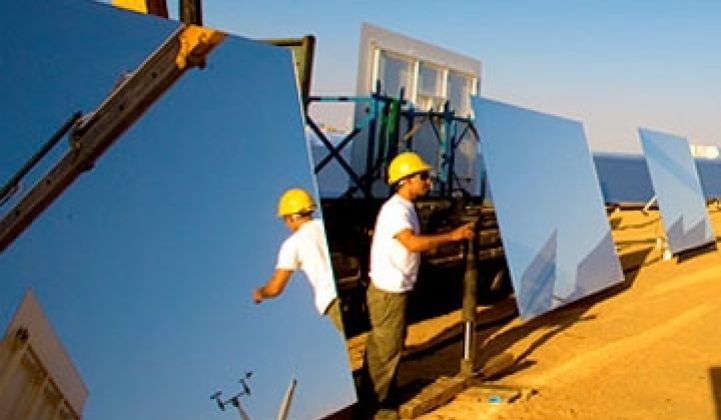One of the big questions in the solar thermal world has been how will start-up BrightSource Energy manage to finance the 2.6 gigawatts worth of power plants it has signed contracts to build.
A large part of the answer came out today when it announced that Bechtel, the grandfather of global engineering, will invest in one of the projects but also will be in charge of engineering and building it.
Bechtel said it would be an equity investor in Ivanpah Solar Electricity Generating System, which is comprised of three power plants in the Mojave Desert totaling 440 megawatts in generation capacities. Oakland, Calif.-based Brightsource has inked contracts to sell the electricity from the power plants to the Pacific Gas and Electric Co. and the Southern California Edison.
Both companies declined to disclose the financial terms of the investment.
Picking Bechtel as a contractor isn't surprising, considering that the San Francisco-based company has experiences building power plants and expressed a strong interest in the solar market (Earlier this year we put it on our list of Top 10 Solar Companies). Other large engineering firms that are angling for solar project deals include CH2M Hill and Lockheed Martin. Because of the infrastructure and retrofits required to replace fossil fuel and increase efficiency, there is a strong likelihood that construction will become the largest segment in greentech.
Lockheed is working on a 290-megawatt solar thermal power plant near Phoenix for developer Starwood Energy Group, and the project would reportedly cost $1.5 billion.
Finding money to build the projects has been a tough challenge for solar thermal power companies, particularly because they typically propose large-scale projects with hundreds of megawatts each.
Many bankers and even utilities have said they are more likely to support proven solar technologies, by which they mean ones that have been put to use for years and generated data to show that they can last. After all, a coal- or gas-fired power plants are built to last for decades.
The daunting task of assemblimg the financing and logistics for building power plants was one of the factors that prompted Ausra and eSolar to focus more on equipment for third parties rather than just build solar thermal plants on their own. Many have speculated that BrightSource wouldn't be able to fulfill their contracts because of the financing issues. It has happened before. Optisolar signed massive deals to build photovoltaic farms for Canadian and U.S. utilties before crumbling under the weight of complex project management.
A solar thermal power plant uses mirrors to concentrate and direct sunlight to heat up water or oil to generate steam. The steam is then piped to turbines for power generation.
There are many types of solar thermal power plant designs, and the one considered most enduring is the "parabolic trough" set up that rely on curved mirrors to heat fluid-carrying tubes for steam production. In the 1980s, nine parabolic trough power plants totaling 354 megawatts went up in southeastern desert of California, and they have continued to produce power for Edison today.
BrightSource's engineering team included those who built those parabolic trough plants, but the company is using another technology commonly called "power tower." This design calls for using flat mirrors to direct the sunlight to the top of a tower containing a water tank for steam generation.
For over a year, the company had discussed starting to build some of its 2.6 gigawatts of projects in late 2009 or early 2010, but hadn't announced how it was going to finance them.
Bechtel's investment would help, but the engineering firm won't be financing the entire Ivanpah project.
BrightSource is hoping to line up a loan guarantee from the U.S. Department of Energy to help pay for the project, said Keely Wachs, a spokesman for Brightsource.
Wachs declined to say how much the company is seeking from the government, or whether the loan would be enough to cover the remainder cost of the project.
BrightSource has declined to divulge the costs of building the Ivanpah project.
The company plans to start building the Ivanpah project in early 2010, after it has secured permits from the California Energy Commission and the federal Bureau of Land Management.
Image via BrightSource.



